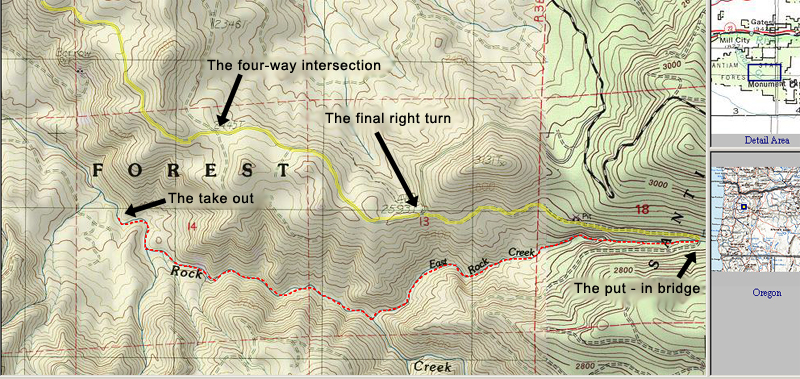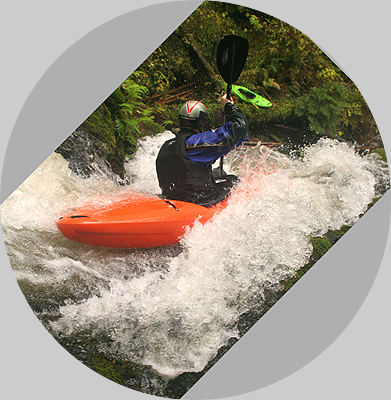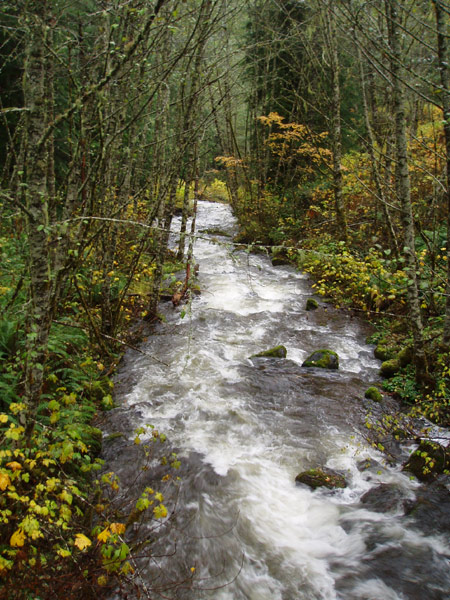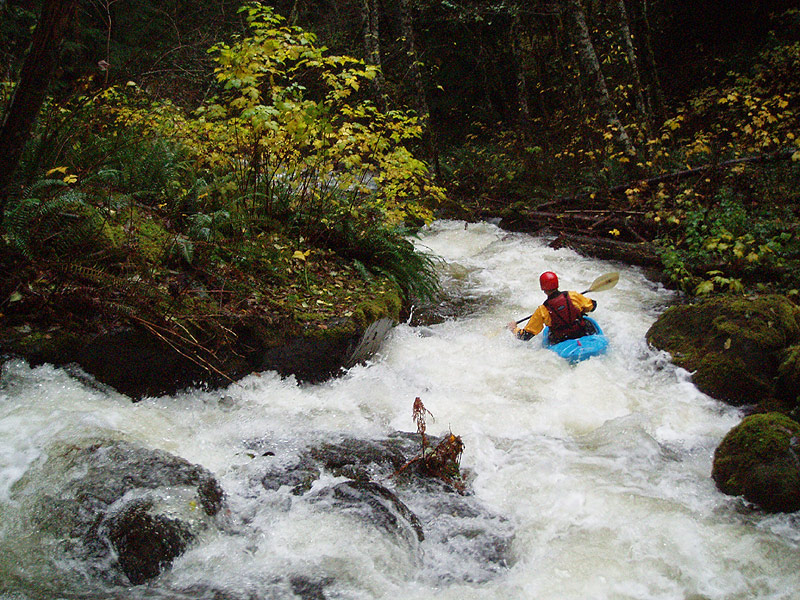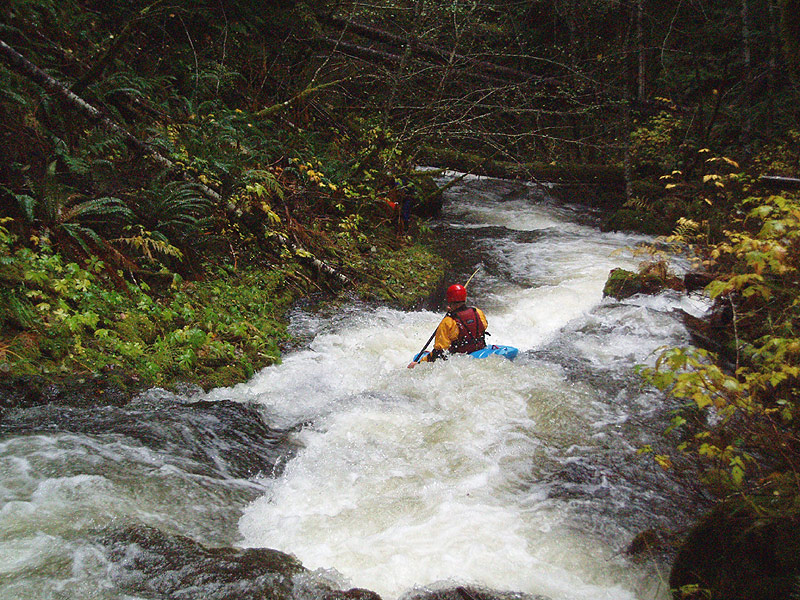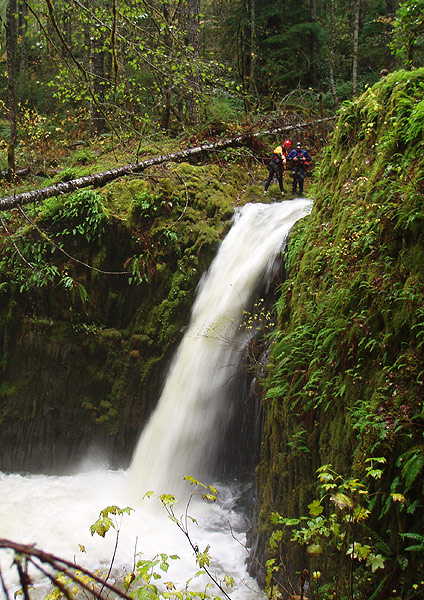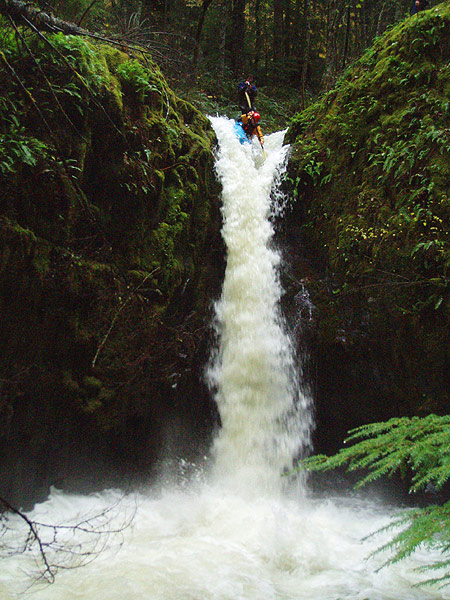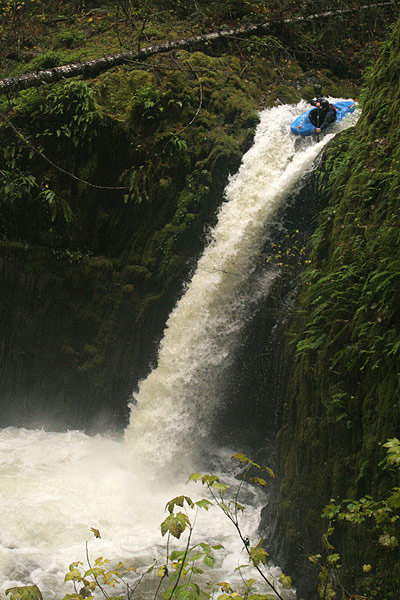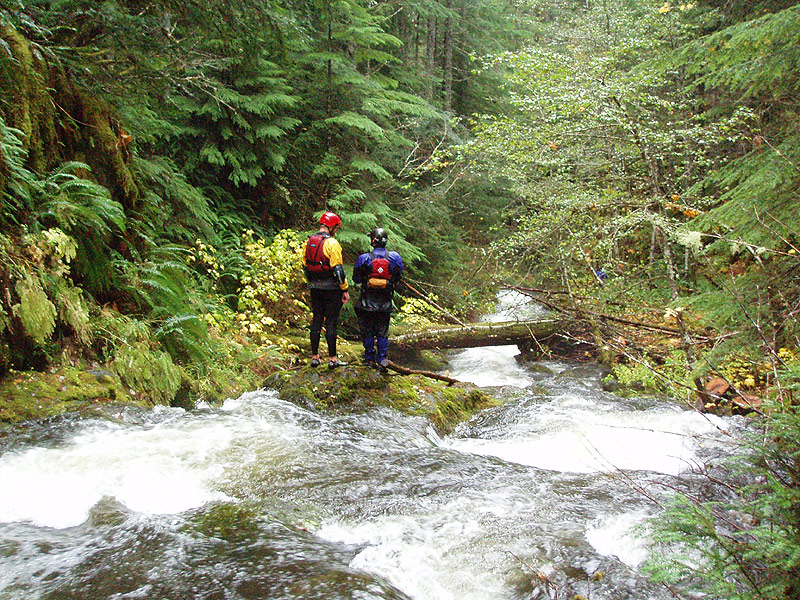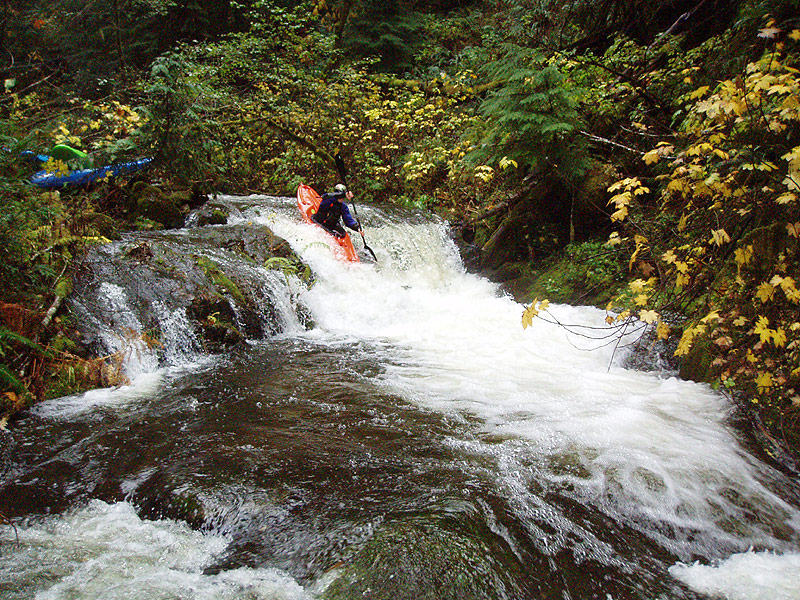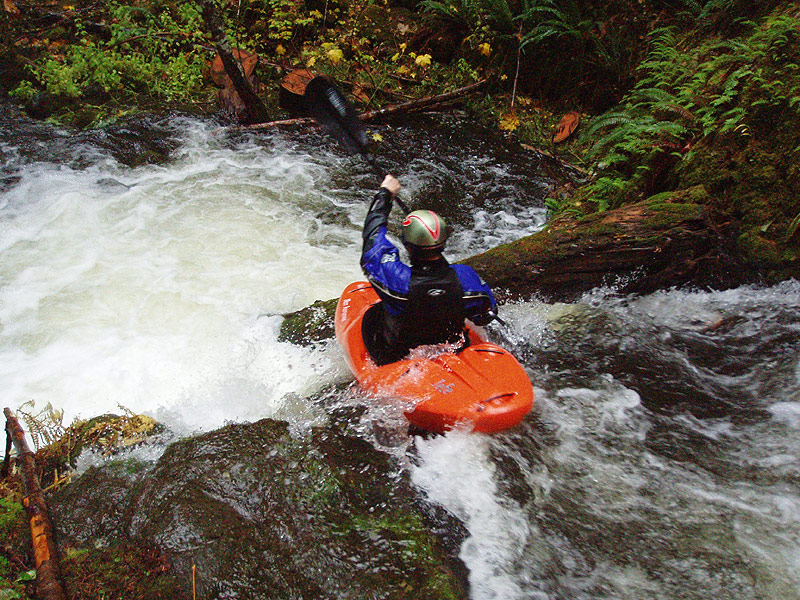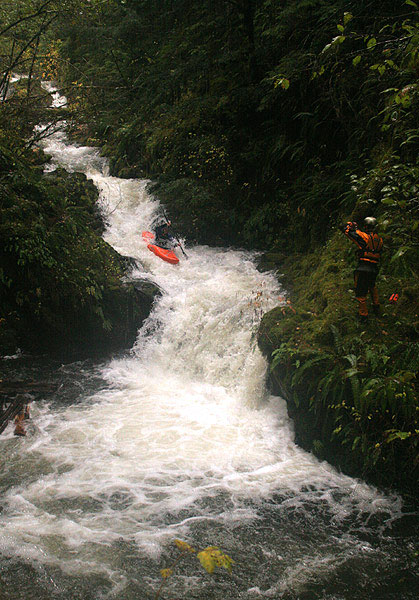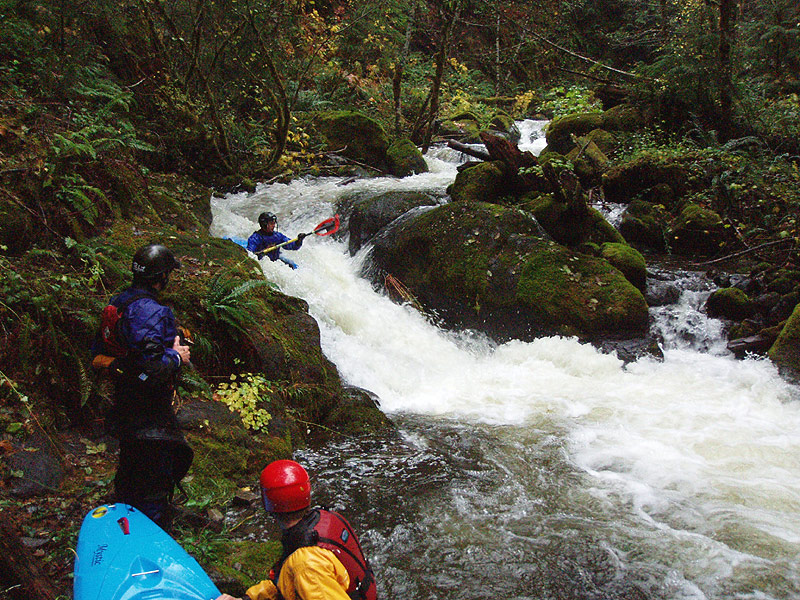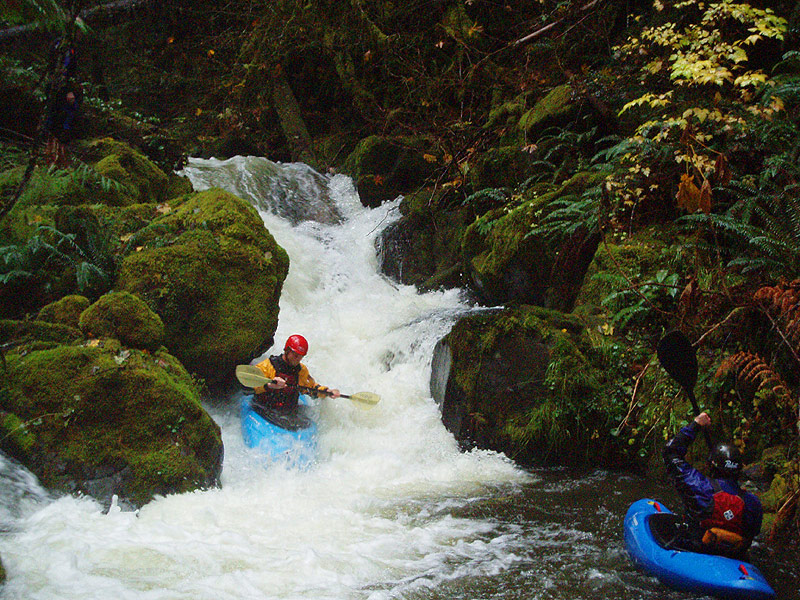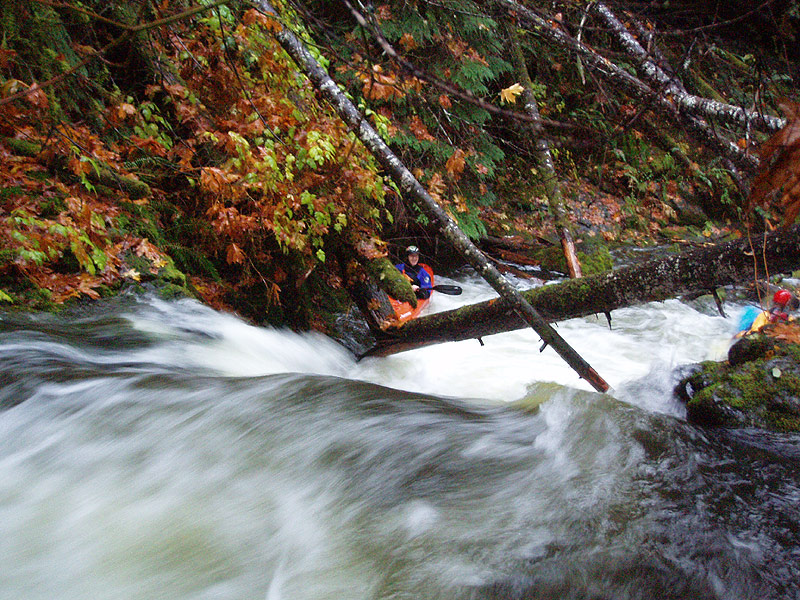James Bagley Jr. gets ready to seal launch after shooting video of us running Crescendo.
The last of three drops making up Crescendo is pictured here.
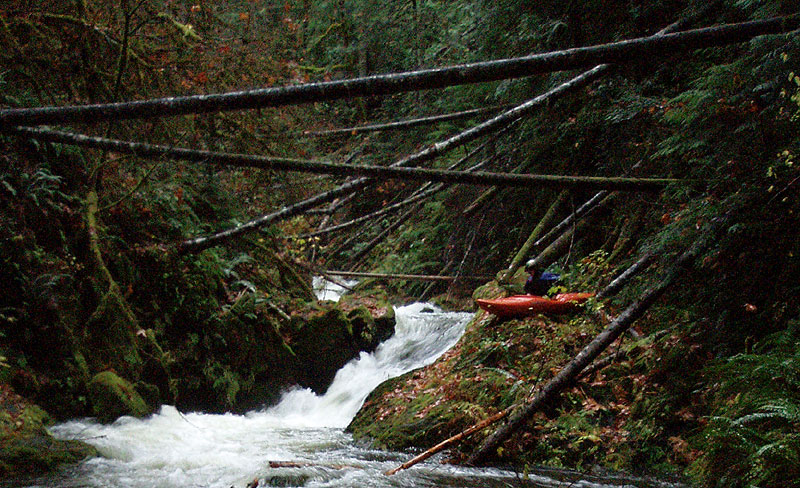
Below Crescendo is Last Caress, a very fun slide that empties into main Rock Creek. Here the flow doubles and becomes Rock Creek ( Pete and I have scouted the west fork, which has tons of wood and trashy drops ).
The main stem of Rock Creek is mellow for awhile, with some small ledges in the five to six foot range which are boat scoutable at medium to low flows but might develop some big holes at higher water.
The first scout-worthy drop is Piledriver, which comes about a mile downstream. At Piledriver the creek flows between vertical walls and turns sharply to the left. This drop is scoutable and/or portagable on the right hand side. It is also possible to set safety on the right. Piledriver is a double drop with some funky hydraulics and a sticky hole at the bottom.
Below Piledriver, the creek mellows and widens. The action picks up again below a huge old growth log that blocks the creek, visible on a straight stretch. Portage on the left, pretty easy walking. Below this huge log ( that fell in during the massive '06 flood ) the creekbed solidifies and accelerates over some bedrock slides as it turns to the left. Run this section and then eddy out right as you go around the blind corner to the right. This rapid used to be known as 'Do or Die' because the final drop here ( where the huge log is teetering on the midstream boulder ) was choked with wood. It is now free of wood on both sides, but it worthy of a quick look. Also scout the log situation just downstream while you are scouting this final drop.
Downstream of Do or Die is a logjam that was blown out in the ten year flood of 2006. Scout this one on the left hand side, it is now runnable but worth a peek for wood. Once below this final jam there is one more large rapid, known as right-right-right. This large boulder garden has three distinct drops, and is run ( you guessed it ) on the right all the way down.
Immediately below Right-right-right is the take out. Eddy out on the left side of the creek and hike up the short trail to the road ( the trail is easy to find, catch the first eddy on the left after the log portage upstream of Jumbleia and you will see the trail ). Just downstream is Jumbleia Falls, a monstrous mess of logs and wood which is nice to look at but not to run. Below Jumbleia is a short gorge with more wood and then a bridge over the creek. It is recommended that you take out above Jumbleia, and save yourself a lot of portaging in the final gorge.

POST-FLOOD UPDATE: After the massive ten-year flood in November 2006 I was a little worried about this creek. In February 2007 we finally had a nice rainstorm so I soloed The Rock to check for wood and other flood damage. This was the third known descent, and I recorded what I found in my 'other adventures' blog.
FLOWS: Amazingly enough, the main fork of Rock Creek has an has an internet gauge located on the USGS site. Unlike Sardine Creek, this run doesn't need a flood event to get going. However, Rock Creek only drains 15 square miles, so storms that move through the area need to score a direct hit in order for the creek to run.
Visually determining flows: The basic rule is that when you arrive at the put-in bridge, the view downstream should resemble the photo at the beginning of this trip report, i.e. there shouldn't be any rocks visible in the middle of the creekbed but you should be able to eddy out on the edges of the channel. If it looks like you are going to be hitting lots of rocks ( too low ) or there are no eddies to be seen ( too high ), I recommend going elsewhere.
The East Fork is a tributary of a the main Rock Creek, so it runs off very quickly after a storm, esp if the rain stops completely. See below for my observed flow dropoff after a big storm. The orange line indicates the actual rate of flow drop of the East Fork vs. the main fork, which is the internet graph. Since 400 cfs is the minimum flow you need on the actual gauge, then you need to take this orange line into consideration, esp. if it has stopped raining and the creek is falling. If this is the case, then 600-700 cfs is actually the minimum flow as indicated by the relationship between the orange bar ( actual flow in the east fork, observed ) and the main creek. In the case of the graph below, the creek was runnable both February 15th and 16th, but not before or after that.
The shaded green area indicates a runnable flow window. The orange line represents the actual flows in EF Rock Creek after rain stops falling in the drainage.
400 cfs on the main gauge is the minimum runnable flow for the EF Rock Creek, but how you arrive at the actual flow depends on whether the creek is falling, rising, or steady.
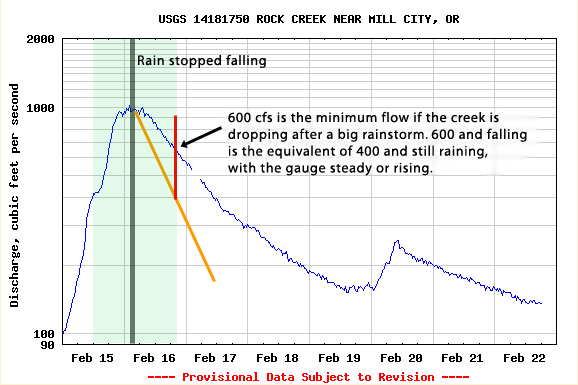
If it is still raining and flows are stable or bouncing around, you can use the actual blue bar on the flow graph. In this case, 400 cfs actual on the flow gauge would be the minimum flow.
An upper flow limit for this run has not yet been established, but it regularly gets up to 2,000-3,000 cfs during big floods. I'm thinking it would get a little hectic at those flows.
The put-in for this run is only about seven miles southeast of Mill City, so checking weather and radar for Mill City should give you a good idea what is going on in the drainage. You can also check the gauge visually, it is located approximately 3.3 miles upstream of the North Santiam on the right back ( just above the first bridge you reach over Rock Creek on the shuttle - the bridge you do not cross - at GPS N 44° 42'44", W 122° 25'35" ).
ACCESS: Access is somewhat complicated even though there are roads the whole way. The take out is pretty easy to find because there are landmarks. The put in is somewhat more complicated, but not too bad. The main thing to remember about driving to the put-in is not to turn too early. There are a couple of dead-end roads that go off to the right down into the canyon ( we took all of these on the first known ) but only one goes all the way to the creek.
First, a zoomed-out map, with the run highlighted in red on the bottom-right.
It is only six miles from the bridge over the North Santiam in Mill City to the put-in for this creek.
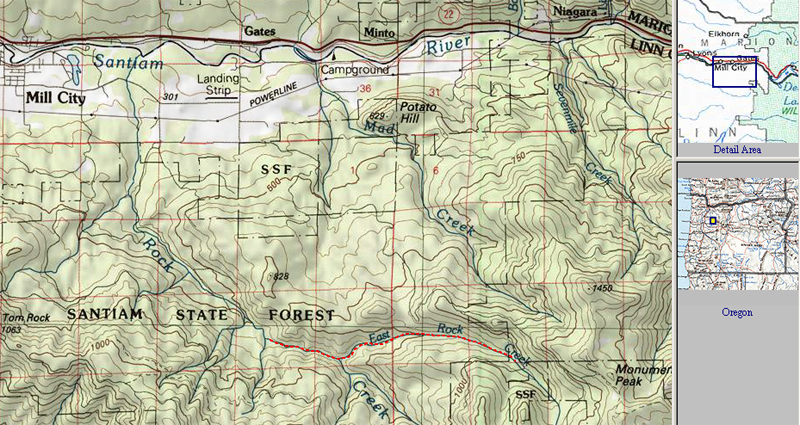
To reach the take-out: Drive to Mill City and cross the North Santiam.
Take the first left after crossing the North Santiam and drive 0.4 miles until the road ends with a T intersection.
Turn left at the T intersection onto Kingwood Road.
After 1.7 miles you will cross Rock Creek, keep going a total of 2.2 miles until you reach Rock Creek road on the right ( a half mile after you cross Rock Creek ).
Turn right on Rock Creek road. Drive 0.5 miles up Rock Creek road until the road bends sharply to the left, stay straight here on a narrow paved road that goes uphill.
After a couple hundred feet turn right by a house on the side of the hill ( if you stay straight you go to the put-in ).
The road turns to gravel as you drive up along the main stem of Rock Creek, which will be visible on your right.
After 1.16 miles you will reach a bridge across the creek. Do not cross the creek, stay left.
After another mile or so you will cross the creek and the road will climb up a steep hill.
You will pass a road on the right side, and then a small creek flowing down the hill on the right side. You will top out, then pass another road going off to the right. From this second road it is .2 miles to the put-in trail. The road will bend to the left and then start going uphill again. When this happens, look on the left side for an old dirt road on this second uphill pitch. This is the put-in trail. If you get to where the road forks you have gone too far.
The old dirt road goes downhill and becomes a trail after about fifty feet, coming in about fifty yards upstream of Jumbleia Falls. The trail is wide and well used, mostly by fishermen and locals who swim in the creek in the summertime. It is about a hundred yards downhill from the road to the creek. It is wise to scout the take out, because it is easy to miss if you don't know where it is. Taking out at Jumbleia Falls is awful, don't try it! The trail is much better.
To reach the put-in: The put in is located at GPS N 44° 42'112" by W 122° 21'765".
Drive 3.26 miles back to the original intersection by the house, and turn right ( going uphill ).
0.36 miles after you turn there will be some roads branching off, stay straight on the main road.
After 0.81 total miles from the house intersection the road will start to go uphill steeply through some switchbacks, this is a good landmark.
After 2.12 total miles there will be a road off to the left, stay straight ( right ).
After 3.38 total miles there is a four way intersection shown on the map below, stay straight here on the main road.
After 4.43 total miles is the key turn shown on the map below, the main road veers left and a less used road bears off to the right ( downhill ) off of the main road.
Turn right here onto the less used road, which will rapidly descend into the East Fork Canyon less than a mile after you turn. After 5.65 total miles you will reach the bridge over the East Fork, which is the put-in.
A zoomed-in map, showing the put in bridge and the take out trail. The shuttle road to the put-in is highlighted in yellow.
